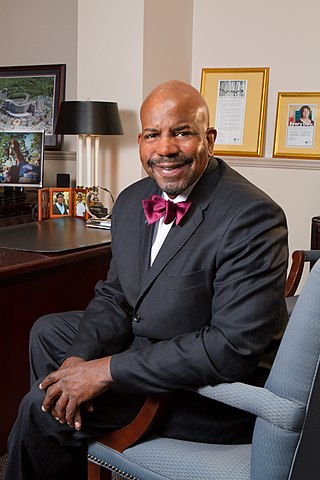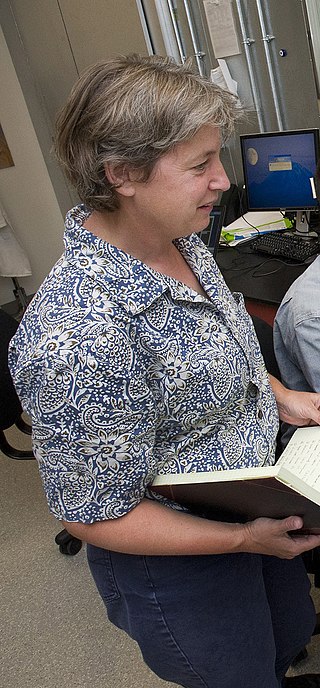Related Research Articles

Applied physics is the application of physics to solve scientific or engineering problems. It is usually considered a bridge or a connection between physics and engineering. "Applied" is distinguished from "pure" by a subtle combination of factors, such as the motivation and attitude of researchers and the nature of the relationship to the technology or science that may be affected by the work. Applied physics is rooted in the fundamental truths and basic concepts of the physical sciences but is concerned with the utilization of scientific principles in practical devices and systems and with the application of physics in other areas of science and high technology.

JEOL, Ltd. is a major developer and manufacturer of electron microscopes and other scientific instruments, industrial equipment and medical equipment.

Cato T. Laurencin FREng SLMH is an American engineer, physician, scientist, innovator and a University Professor of the University of Connecticut.

Nestor J. Zaluzec is an American scientist and inventor who works at Argonne National Laboratory. He invented and patented the Scanning Confocal Electron Microscope. and the π Steradian Transmission X-ray Detector for Electron-Optical Beam Lines and Microscopes.
David Bernard Williams was the dean of the College of Engineering at the Ohio State University from 2011-2021. He was previously the fifth president of the University of Alabama in Huntsville in Huntsville, Alabama from March 2007 until April 2011, and Vice Provost for Research and Harold Chambers Senior Professor of Materials Science and Engineering at Lehigh University in Bethlehem, Pennsylvania.

Dame Pratibha Laxman Gai-Boyes is a British microscopist and Professor and Chair of Electron Microscopy and former Director at The York JEOL Nanocentre, Departments of Chemistry and Physics, University of York. She created the atomic-resolution environmental transmission electron microscope (ETEM) and is an outspoken advocate for women with careers in science.

Paul Anthony Midgley FRS is a Professor of Materials Science in the Department of Materials Science and Metallurgy at the University of Cambridge and a fellow of Peterhouse, Cambridge.

Emily A. Carter is the Gerhard R. Andlinger Professor in Energy and the Environment and a professor of Mechanical and Aerospace Engineering (MAE), the Andlinger Center for Energy and the Environment (ACEE), and Applied and Computational Mathematics at Princeton University. She is also a member of the executive management team at the Princeton Plasma Physics Laboratory (PPPL), serving as Senior Strategic Advisor and Associate Laboratory Director for Applied Materials and Sustainability Sciences.

Sergei V. Kalinin is a corporate fellow at the Center for Nanophase Materials Sciences (CNMS) at Oak Ridge National Laboratory (ORNL). He is also the Weston Fulton Professor at the Department of Materials Science and Engineering at the University of Tennessee-Knoxville.

Eric Andrew Stach is an American materials scientist who is a professor at the University of Pennsylvania and an elected fellow of both the American Physical Society and the Microscopy Society of America. He was also awarded the Eli F. Burton Award in 2009. He was named a "Highly Cited Researcher" in the newly established Cross-Field category in 2018.

Frances Mary Ross is the Ellen Swallow Richards Professor in Materials Science and Engineering at Massachusetts Institute of Technology. Her work involves the use of in situ transmission electron microscopy to study nanostructure formation. In 2018 she was awarded the International Federation of Societies for Microscopy Hatsujiro Hashimoto Medal. Ross is a Fellow of the American Association for the Advancement of Science, the American Physical Society, the Microscopy Society of America and the Royal Microscopical Society,
Caterina Ducati is a Professor of Nanomaterials in the Department of Materials at the University of Cambridge. She serves as Director of the University of Cambridge Master's programme in Micro- and Nanotechnology Enterprise as well as leading teaching in the Nanotechnology Doctoral Training Centre.

Dawn Austin Bonnell is the Senior Vice Provost for Research at the University of Pennsylvania. She has previously served as the Founding Director of the National Science Foundation Nano–Bio Interface Center, Vice President of the American Ceramic Society and President of the American Vacuum Society.
Stephanie Lee Brock is an American chemist who is professor of inorganic chemistry at Wayne State University. Her research considers transition metal pnictides and chalcogenide nanomaterials. She is a Fellow of the American Association for the Advancement of Science and the American Chemical Society.
Sara Bals is a Belgian nanoscientist known for her research on electron tomography and its application in the study of nanomaterials such as perovskite nanocrystals. She is a professor of electron microscopy for materials science at the University of Antwerp.
Katherine Jungjohann is a group leader at the National Renewable Energy Laboratory (NREL) and previously worked as a scientist and engineer at the Center for Integrated Nanotechnologies (CINT) which is part of Sandia National Laboratories in Albuquerque, New Mexico, United States.

KatalinBalázsi is a Slovakia-born Hungarian material scientist. She is the head of the Thin Film Physics department in the Institute of Technical Physics and Materials Science, a component of the Centre for Energy Research, Eötvös Lóránd Research Network. She has also served as the President of the Association of Hungarian Women in Science (2018-2021).

Miaofang Chi is a distinguished scientist at the Center for Nanophase Materials Sciences in Oak Ridge National Laboratory. Her primary research interests are understanding interfacial charge transfer and mass transport behavior in energy and quantum materials and systems by advancing and employing novel electron microscopy techniques, such as in situ and cryogenic scanning transmission electron microscopy. She was awarded the 2016 Microscopy Society of America Burton Medal and the 2019 Microanalysis Society Kurt Heinrich Award. She was named to Clarivate's list of Highly Cited Researchers in 2018 and 2020.

Zhong Lin Wang is a Chinese-American physicist, materials scientist and engineer specialized in nanotechnology, energy science and electronics. He received his PhD from Arizona State University in 1987. He is the Hightower Chair in Materials Science and Engineering and Regents' Professor at the Georgia Institute of Technology, US.
Elizabeth Carol Dickey is an American materials scientist, Head of department and the Teddy and Wilton Hawkins Distinguished Professor at Carnegie Mellon University. Her research considers structure-property relationships for materials with grain boundaries and interfaces. She is a Fellow of the American Association for the Advancement of Science, the American Ceramic Society and the Microscopy Society of America.
References
- 1 2 "C. Barry Carter". Materials Science and Engineering. Retrieved 2021-03-23.
- ↑ "People". CINT. 2012-11-20. Retrieved 2021-03-23.
- 1 2 "Journal of Materials Science". Springer. Retrieved 2021-03-23.
- ↑ "Buhrman Research Group -- Home". Buhrman Research Group -- Home. Retrieved 2021-03-23.
- 1 2 3 "Group". The Carter Research Group. 2020-02-07. Retrieved 2021-03-23.
- ↑ https://cint.lanl.gov/meet-cint/index.shtml Retrieved 2023-11-20
- ↑ Transmission Electron Microscopy - A Textbook for Materials Science - David B. Williams. Springer. Retrieved 2021-03-23.
- ↑ Ceramic Materials - Science and Engineering - C. Barry Carter. Springer. Retrieved 2021-03-23.
- ↑ Transmission Electron Microscopy - Diffraction, Imaging, and Spectrometry - Barry Carter. Springer. Retrieved 2021-03-23.
- ↑ "International Federation of Societies for Microscopy (IFSM) Contact Page". Archived from the original on 2016-08-28. Retrieved 2016-08-09.
- 1 2 "MSE Professor C. Barry Carter Awarded Ceramic Educational Council Outstanding Educator Award for 2014". Materials Science and Engineering. Retrieved 2021-03-23.
- ↑ "World Premier International Research center Initiative Progress Report" (PDF). www.jsps.go.jp. Retrieved 2021-03-23.
- ↑ "Dr. Barry Carter to Receive Distinguished Scientist Award". School of Engineering News. 2013-04-04. Retrieved 2021-03-23.
- ↑ "AAAS Fellows membership list, Fall 2011" (PDF). Archived from the original (PDF) on 2015-04-21. Retrieved 2016-08-12.
- ↑ "MRC volume 3 issue 2 Cover and Back matter - MRS Communications". MRS Communications. 3 (2): b1–b2. 2013-07-09. doi: 10.1557/mrc.2013.23 . ISSN 2159-6859.
- ↑ "C. Barry Carter". Chemical & Biomolecular Engineering. 29 July 2016. Retrieved 2021-03-23.
- ↑ "Connecticut Academy of Science & Engineering". Member public profile. Retrieved 2021-03-23.